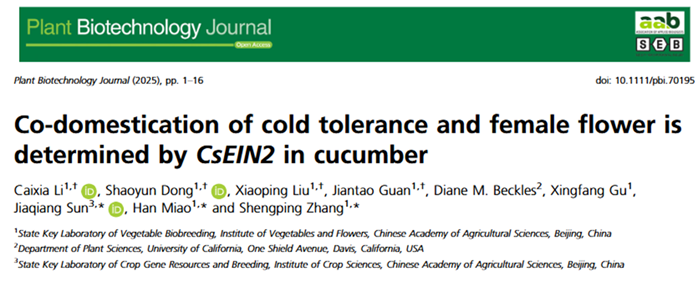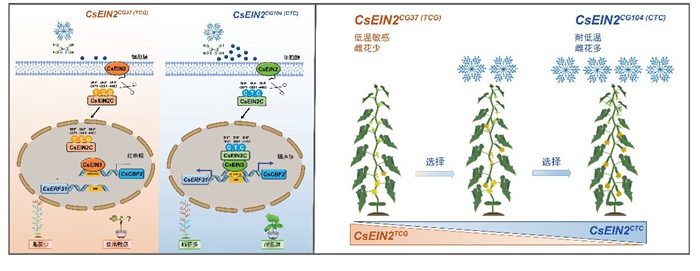Researchers revealed the key gene determining the co-domestication of cold tolerance and female flower in cucumber
Recently, Cucurbitaceae Vegetable Genetics and Breeding Group in the Institute of Vegetables and Flowers (IVF, CAAS) uncovered CsEIN2 as a hub gene in regulating both cold tolerance and female flower percentage (FFP) in cucumber, and explored the underlying molecular mechanism. Additionally, three completely linked natural allelic variants CsEIN2CTC were selected for adaptation to high latitude regions, which provides a valuable breeding framework for improving cucumber yield and adaptability. The research findings were published in Plant Biotechnology Journal.

Survive and successful reproduction at cold stress are critical for cucumber adaptation toenvironmental conditions in high-latitude regions. However, the molecular basis for theco-domestication of cold adaptation and reproductive success in cucumber remains unknown. Here, we demonstrate that CsEIN2 acts as an indispensable hub in regulating both cold tolerance and FFP in cucumber. Specifically, we discover that three completely linked natural variations at the C-terminus of CsEIN2, that is, the CsEIN2CTC and CsEIN2TCG haplotypes determine the differences in cold tolerance and FFP. These variations affect the interaction of CsEIN2 with the transcription factor CsEIN3, which activates the expression of target genes such as CsCBF2 and CsERF31 to regulate cold tolerance and FFP, respectively. Interestingly, the geographical distribution analyses show that the CsEIN2CTC haplotype, conferring higher cold tolerance and FFP, underwent artificial selection for adaptation to environmental conditions in high-latitude regions. Further, we find that CsEIN2 is the only sex determination gene for selection of both cold tolerance and FFP. Collectively, our findings not only establish CsEIN2 as a 'hub' regulator that enhances cold tolerance and FFP, but also provides a target gene for breeding.

Figure 1. A proposed working model for the co-domestication of cold tolerance and female flower development mediated by CsEIN2.
The research was supported by the Basic Research Center for Horticultural, the National Natural Science Foundation of China, the National Key Research and Development Program of China, the Earmarked Fund for Modern Agro-industry Technology Research System, the Agricultural Science and Technology Innovation Program of the Chinese Academy of Agricultural Sciences, State Key Laboratory of Vegetable Biobreeding, and the Key Laboratory of Biology and Genetic Improvement of Horticultural Crops, Ministry of Agriculture, P.R. China.
Link to this paper: https://onlinelibrary.wiley.com/doi/10.1111/pbi.70195
By Shaoyun Dong(dongshaoyun@caas.cn)
-
 Jul 09, 2025CAAS President meets with WUR Executive Board Member
Jul 09, 2025CAAS President meets with WUR Executive Board Member -
 Jul 09, 2025CAAS President Meets with AAS President
Jul 09, 2025CAAS President Meets with AAS President -
 Jul 09, 2025Secretary of the Leadership Party Group of CAAS Meets with Secretary of the Brazilian Ministry of Agriculture and Livestock
Jul 09, 2025Secretary of the Leadership Party Group of CAAS Meets with Secretary of the Brazilian Ministry of Agriculture and Livestock -
 Jul 09, 2025CAAS Deepens Scientific Cooperation with IAEA
Jul 09, 2025CAAS Deepens Scientific Cooperation with IAEA -
Jul 09, 2025CAAS Deepens Agricultural Science and Technology Cooperation with Eastern European Countries
